Project Launch
Indus River dolphin (Platanista minor) which is locally known as Bulhan occurs only in the Indus River in Pakistan.
Population of Bulhan in Indus River from Jinnah Barrage to Kotri Barrage is just around 1400 which is not very healthy number
Population of Bulhan in Indus River from Jinnah Barrage to Kotri Barrage is just around 1400 which is not very healthy number
Conservation of Indus River Dolphin through Community based Ecotourism at Taunsa Barrage” will work to create awareness about the protection of Bulhan among the local fisher communities
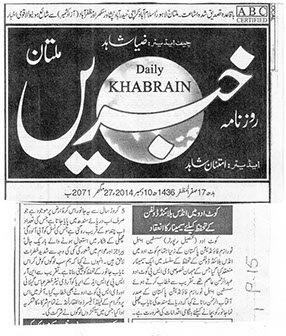
STFP Launches Ecotourism Project for Conservation of Unique Indus River Dolphin
Multan: sustainable Tourism Foundation Pakistan (STFP) a non-profit organization dedicated to the promotion of Eco-friendly tourism in Pakistan has launched a project with the help of NRSP-USAID Small Grants and Ambassador’s Fund Program for seeking fishermen community and general public support for the conservation of unique Indus Blind Dolphin. Mr. Abdur Rehman Asim, DSP of Kot Addu was Chief Guest on this occasion. In this connection, a project launching ceremony was held on 9th December at Aroma Hotel at Kot Addu which was attended by large number of people from different walks of life including government officials from different departments, local community from Indus River, representatives of various NGOs and media. Giving a detailed presentation on the project, Aftab Rana, President of Sustainable Tourism Foundation informed that the Indus River dolphin (Platanista minor) which is locally known as Bulhan occurs only in the Indus River in Pakistan. It is also known as Indus blind dolphin as it is functionally blind due to its unique adaptation to living in turbid river environment over the long period of time.
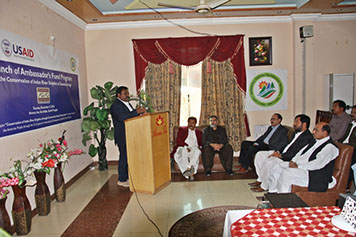 He informed that historically these dolphins were found in large number right from the Indus estuary up into the foothills of the Himalayas but now the current population of Bulhan in Indus River from Jinnah Barrage to Kotri Barrage is just around 1400 which is not very healthy number for the survival of any wild animal species due to which it is listed as an “Endangered Species” by the World Conservation Union (IUCN). While talking about the main threats to Indus Blind Dolphin he informed that the barrages on the river are the main cause of its highly fragmented habitat due to which these dolphins live in small populations which have been separated by impassable barrages across the Indus River.More over dolphins are being killed due to lack of awareness among the local communities. Hunting of Bulhanin order to extract oil which was used in medicines by locals was reported in history. Many people are not familiar with this animal and sometimes dolphins swim along irrigation canals and become trapped in narrow channels where they are killed by local people considering it some dangerous animal because of its snout resemblance with the crocodile. He further said that a significant increase is observed in illegal fishing practices in the past few years where pesticide poisoning is used to maximize fish catch.
He informed that historically these dolphins were found in large number right from the Indus estuary up into the foothills of the Himalayas but now the current population of Bulhan in Indus River from Jinnah Barrage to Kotri Barrage is just around 1400 which is not very healthy number for the survival of any wild animal species due to which it is listed as an “Endangered Species” by the World Conservation Union (IUCN). While talking about the main threats to Indus Blind Dolphin he informed that the barrages on the river are the main cause of its highly fragmented habitat due to which these dolphins live in small populations which have been separated by impassable barrages across the Indus River.More over dolphins are being killed due to lack of awareness among the local communities. Hunting of Bulhanin order to extract oil which was used in medicines by locals was reported in history. Many people are not familiar with this animal and sometimes dolphins swim along irrigation canals and become trapped in narrow channels where they are killed by local people considering it some dangerous animal because of its snout resemblance with the crocodile. He further said that a significant increase is observed in illegal fishing practices in the past few years where pesticide poisoning is used to maximize fish catch. 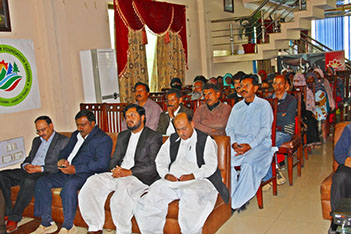 Use of overnight fishing nets has also negatively impacted on the Indus River Dolphin. He said water pollution is an other serious threat to the existing small population of the Bulhan. Especially in winter when water level is low, the level of pollution increases. Heavy use of pesticides and chemical fertilizers on agricultural lands add harmful chemicals into the Indus River though runoff water which pollute the habitat of the dolphins. He stressed that if we did not pay serious attention to these threats the time will come that this rare species of dolphin will be completely vanished from the earth. While giving details of about project, he informed the audience that the project “Conservation of Indus River Dolphin through Community based Ecotourism at Taunsa Barrage” will work to create awareness about the protection of Bulhan among the local fisher communities, concerned stakeholders and general public to minimize the threats through the mass awareness campaign. He said, through local community involvement and empowerment the project will also foster community-based “stewardship” for the conservation of Bulhan in the area of Taunsa Barrage, providing alternate source of income to the fishermen through ecotourism. He said, ecotourism is special concept which promotes an environmentally friendly, culturally sensitive tourism and it is designed in a way that the maximum economic benefit of such tourism activity could reach to the local community. Under the project efforts will be made to build the capacity of local community to improve their services and skills to deal with nature loving tourists who will be willing to come for dolphin watching, bird watching and having unique experience of rural life of South Punjab in organized groups from main cities of Pakistan and from abroad. He said that the income from the ecotourism activity will be an incentive and reward for the poor fishermen community and it will encourage them to be friendlier with Indus River dolphin and play active role to conserve one of the most unique species living in the world today.
Use of overnight fishing nets has also negatively impacted on the Indus River Dolphin. He said water pollution is an other serious threat to the existing small population of the Bulhan. Especially in winter when water level is low, the level of pollution increases. Heavy use of pesticides and chemical fertilizers on agricultural lands add harmful chemicals into the Indus River though runoff water which pollute the habitat of the dolphins. He stressed that if we did not pay serious attention to these threats the time will come that this rare species of dolphin will be completely vanished from the earth. While giving details of about project, he informed the audience that the project “Conservation of Indus River Dolphin through Community based Ecotourism at Taunsa Barrage” will work to create awareness about the protection of Bulhan among the local fisher communities, concerned stakeholders and general public to minimize the threats through the mass awareness campaign. He said, through local community involvement and empowerment the project will also foster community-based “stewardship” for the conservation of Bulhan in the area of Taunsa Barrage, providing alternate source of income to the fishermen through ecotourism. He said, ecotourism is special concept which promotes an environmentally friendly, culturally sensitive tourism and it is designed in a way that the maximum economic benefit of such tourism activity could reach to the local community. Under the project efforts will be made to build the capacity of local community to improve their services and skills to deal with nature loving tourists who will be willing to come for dolphin watching, bird watching and having unique experience of rural life of South Punjab in organized groups from main cities of Pakistan and from abroad. He said that the income from the ecotourism activity will be an incentive and reward for the poor fishermen community and it will encourage them to be friendlier with Indus River dolphin and play active role to conserve one of the most unique species living in the world today.
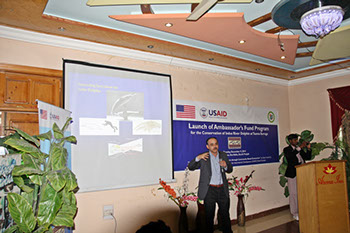 He thanked NRSP-USAID Small Grants and Ambassador’s Fund Program for launching this project. On this occasion Mr. Khizer Gelani, Coordinator of NRSP-USAID Small Grants and Ambassador’s Fund Program also addressed the gathering and highlighted various features of this his funding program. In his closing remarks Chief Guest, Mr. Abdur Rehman Asim, DSP of Kot Addu appreciated the efforts of STFP for the involvement of local community by building their capacity for engaging them in economic activity which is also helpful for Indus Blind Dolphin Conservation. Zulifqar Ali, Project Field Officer thank all the stakeholders who participated in large number in this event.
He thanked NRSP-USAID Small Grants and Ambassador’s Fund Program for launching this project. On this occasion Mr. Khizer Gelani, Coordinator of NRSP-USAID Small Grants and Ambassador’s Fund Program also addressed the gathering and highlighted various features of this his funding program. In his closing remarks Chief Guest, Mr. Abdur Rehman Asim, DSP of Kot Addu appreciated the efforts of STFP for the involvement of local community by building their capacity for engaging them in economic activity which is also helpful for Indus Blind Dolphin Conservation. Zulifqar Ali, Project Field Officer thank all the stakeholders who participated in large number in this event.
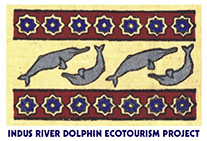
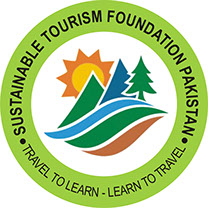
Useful web links
Feedback
Contact Us
Testimonials
This website is made possible by the support of the American people through the United States Agency for International Development (USAID). The contents are the sole responsibility of Sustainable Tourism Foundation Pakistan and do not necessarily reflect the views of USAID or the United States Government.
Copyright@2015 STFP
.gif?crc=178793418)